| |
1890
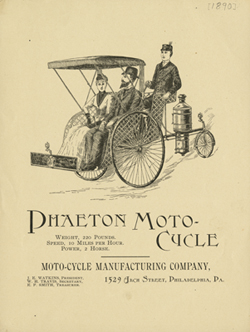 |
The Phaeton Moto-Cycle, a steam-powered vehicle based on Lucius D. Copeland’s patent, was proposed to be made by the Moto-Cycle Manufacturing Company of Philadelphia in 1890. THF85137 |
This advertisement for the “Phaeton Moto-Cycle” is possibly the first ad for a self-propelled vehicle to appear in a magazine. The three-wheel steam-propelled vehicle was based on Lucius D. Copeland’s patented 1886 prototype vehicle built for him by the Northrop Manufacturing Company of Camden, New Jersey. Copeland drove this steam tricycle in Camden and nearby New Jersey towns as well as Philadelphia, seeking investment partners. The Moto-Cycle Manufacturing Company of Philadelphia acquired Copeland’s patent. This short-lived company existed only in 1890 and was not able to sell any vehicles.
It is possible that the company handed out this 8x6 inch advertisement as a sales broadside rather than having it published in a magazine, since it is printed only on one side. In either case, it is an intriguing example of early automotive advertising artwork.
November 1895
There is a three-way tie for the appearance of the first automobile advertisement in a nationally-distributed periodical. Not surprisingly, automotive-related advertisements are found in the very first issue of The Horseless Age, a special interest periodical aimed at bicycle and automobile enthusiasts, inventors, and manufacturers that began publication in November 1895. This inaugural issue included ads for motors to be used in vehicles: American Motor Company of New York City; Daimler Motor Company (making motor carriages in Germany, but only making gasoline motors in Long Island City, New York at this time); and Charles B. King of Detroit, Michigan. Only the following three ads advertise complete automobiles.
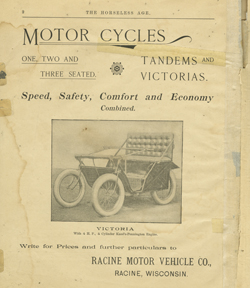 |
Racine Motor Vehicle Company’s full-page advertisement for the “Victoria” from The Horseless Age, November 1895. THF85128 |
The Racine Motor Vehicle Company of Wisconsin advertised their “Victoria,” powered by a 4-cylinder “Kane-Pennington Engine,” in a full-page advertisement that appeared on page two of The Horseless Age. This vehicle, which resembled a small carriage with four pneumatic tires, was the brain-child of Edward Joel Pennington--known more for his success obtaining investors’ money than successful automotive manufacturing. For this venture, Pennington received funds from local industrialist, Thomas Kane. A few of these cars were built in 1895 and 1896, but the vehicle did not operate very well. The company quickly folded.
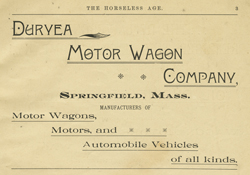 |
Duryea Motor Wagon half-page advertisement for “Motor Wagons, Motors, and Automobile Vehicles of all kinds” in The Horseless Age, November 1895. THF85129 |
The Duryea Motor Wagon Company placed this non-illustrated advertisement on page three of the November 1895 issue of The Horseless Age, touting the company’s gasoline-powered automobile. The Duryea brothers, Charles E. and J. Frank, had opened their factory in Springfield, Massachusetts just two months before. The Duryeas produced 15 cars at this factory from 1895 to1896. The brothers were active in several early American automobile companies, together and separately. They are credited with building a total of 731 prototype and production cars from 1893-1917.
The De La Vergne Refrigerating Machine Company placed the third ad for vehicles. On page four of The Horseless Age, the company stated in their non-illustrated ad that they were “prepared to contract for Wagon Motors or Motor Wagons.” This New York City-based manufacturer worked with two companies, Hincks & Johnson of Bridgeport, Connecticut, and Valentine, Linn & Son of Brooklyn, New York, to produce at least four “motor wagons” and eight “motorcycles” from 1895 to1896.
February 1896
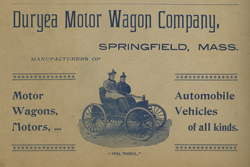 |
This Duryea Motor Wagon Company half-page advertisement for the “1896 Model” in the February 1896 issue of The Horseless Age depicts two women--one driving the vehicle. THF85130 |
When the Duryea Motor Wagon Company ran this advertisement on the inside back cover of The Horseless Age in February 1896, it was probably the first American magazine advertisement with an illustration showing a woman driving the automobile.
May 1898
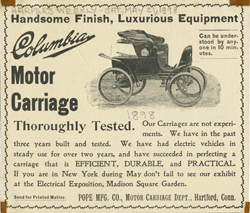 |
This small, two-column Columbia Motor Carriage advertisement was clipped from the May 21, 1898 issue of Harper’s Weekly. THF85136 |
This Pope Manufacturing Company advertisement appeared in the May 21, 1898 issue of Harper’s Weekly, a popular illustrated magazine with a wide national circulation that featured articles on current events, fiction stories, and political cartoons. The Hartford, Connecticut company named their electrically-powered Columbia motor carriage after their well-known bicycle of the same name. Started by Col. Albert A. Pope, this company produced and sold 73 electric vehicles in 1898. Later iterations of the company made thousands of electric and gasoline automobiles with the Columbia model name continuing until 1913.
July 1898
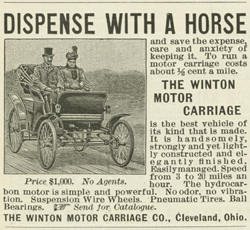 |
This small, one-column Winton Motor Carriage ad from the July 30, 1898 issue of Scientific American featured an illustration of a man and woman in the two-seater. THF85135 |
This advertisement for the Winton motor carriage – the one often identified as the first American automobile advertisement – appeared on page 80 of the July 30, 1898 issue of Scientific American magazine, a nationally-distributed weekly for readers interested in reading about the latest innovations in science, industry and transportation. Winton’s gasoline-powered vehicle had four pneumatic tires and a “hydrocarbon motor.” The Winton Company advertised weekly in this magazine from July through December 1898 and into 1899. The illustration remained the same throughout 1898, although the ad’s title changed from week to week, usually repeating a second time. The title of the first ad, “Dispense with a Horse,” was repeated again August 13. The Winton Company of Cleveland, Ohio made and sold tens of thousands of vehicles from 1896 to 1924.
September 1898
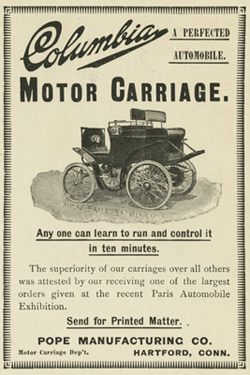 |
The Pope Manufacturing Company claimed in this 1898 quarter-page ad that anyone could learn to drive their “perfected automobile” in ten minutes. THF85125 |
This Columbia motor carriage advertisement appeared on page three of the September 1898 issue of The Cosmopolitan, a “first class family magazine” that included fiction stories and reviews of books. The ad featured a slightly different view of this electric vehicle and included “A Perfected Automobile” as part of the title.
September 1899
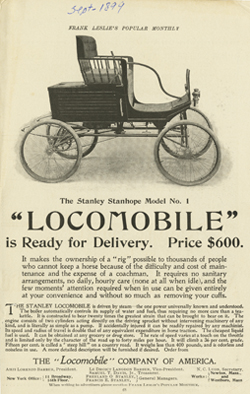 |
This full-page Locomobile ad from 1899 pointed out the convenience of automobile ownership over keeping a horse. THF85126 |
This Locomobile advertisement appeared on page 63 of Frank Leslie’s Popular Monthly, a general interest magazine widely read by the American public during the late 19th and early 20th century. The ad depicts a steam-powered carriage built by the Stanley brothers for the newly formed Locomobile Company of America, located in Watertown, Connecticut. Locomobile produced and sold 337 steam-powered vehicles, and continued to manufacture steam-, and then, gasoline-powered automobiles through 1929.
These ads provide a fascinating window into what would become major industries in America—the automobile and automobile advertising. They also provide a glimpse of the special interest and popular periodicals that some manufacturers and inventors used to promote this innovative means of transportation to an intrigued American public. Some of these periodicals would flourish into the 20th century. Others would fade away as quickly as the automobiles whose ads they carried.
| |
-- Cynthia Read Miller, Curator of Photographs and Prints
|
|

